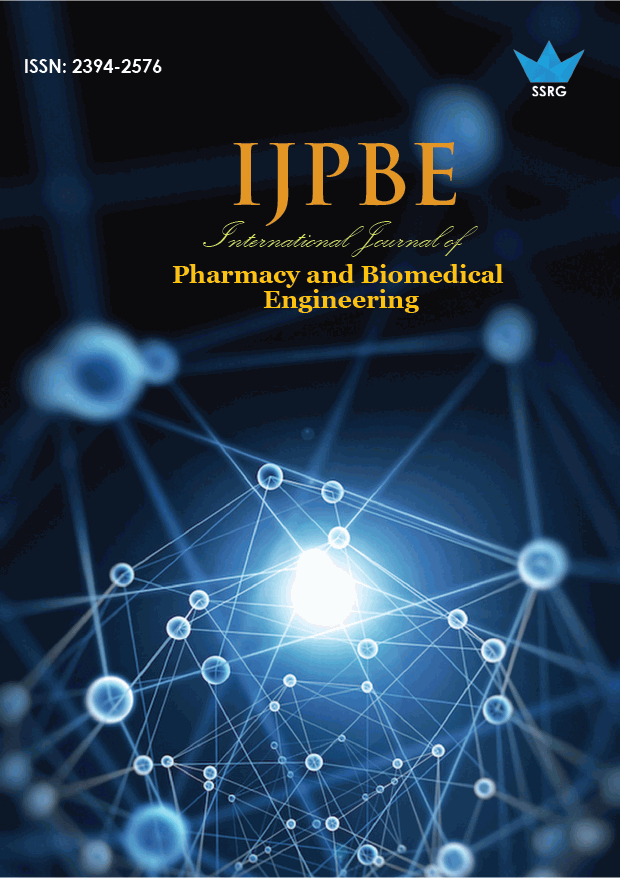Preparation and Evaluation of Biocompatible Composite for Bone Tissue Engineering

| International Journal of Pharmacy and Biomedical Engineering |
| © 2017 by SSRG - IJPBE Journal |
| Volume 4 Issue 3 |
| Year of Publication : 2017 |
| Authors : Md. Masud Rana, Naznin Akhtar, Md. Zahid Hasan and S.M. Asaduzzaman |
How to Cite?
Md. Masud Rana, Naznin Akhtar, Md. Zahid Hasan and S.M. Asaduzzaman, "Preparation and Evaluation of Biocompatible Composite for Bone Tissue Engineering," SSRG International Journal of Pharmacy and Biomedical Engineering, vol. 4, no. 3, pp. 8-15, 2017. Crossref, https://doi.org/10.14445/23942576/IJPBE-V4I3P102
Abstract:
Bone tissue engineering with cells and synthetic extracellular matrix represents a new approach for the regeneration of mineralized tissue than bone transplantation. Hydroxyapatite (HA) and its composite with a biopolymer are extensively developed and applied in bone tissue regeneration. This study's main aim was to fabricate and characterize HA apatite-based biocompatible scaffold for bone tissue engineering. Scaffolds with different polymers (chitosan & alginate) ratios and a fixed amount of synthetic HA were prepared using in situ co-precipitation method. The mineral to polymer ratio was 1:1 to 1: 2. A crosslinker agent, 2-Hydroxylmethacrylate (HEMA), was added at a different percentage (0.5-2%) into the selected composition and irradiated at 5- 25 kGy to optimize the proper mixing of components at the presence of HEMA. Fabricated scaffolds were analyzed to determine porosity, density, biodegradability, morphology, and structural properties. The prepared scaffold's porosity and density were 75 to 92% and 0.21 to 0.42 g/cm3, respectively. However, the swelling ratio of the fabricated scaffolds was ranged from 133 to 197%. Nonetheless, there had a reasonable in-vitro degradation of prepared scaffolds. Flourier transform infrared spectroscopy (FTIR) analysis showed intermolecular interaction between components in the scaffold. A scanning electron microscope measured the scaffold's pore size, and the value was 162-510 µm. It could be proposed that this scaffold fulfills all the main requirements to be considered as a bone substitute for biomedical applications shortly.
Keywords:
Bone tissue engineering, Scaffold, Chitosan, Alginate, Hydroxyapatite.
References:
[1] Naderi H, Matin MM & Bahrami AR (2015). “Critical Issues in Tissue Engineering: Biomaterials, Cell Sources, Angiogenesis, and Drug Delivery Systems”. Journal of Biomaterials Applications, 26: 383-417.
[2] Kim MS, Kim JH, Min BH, Chun HJ, Han DK & Lee HB (2011). “Polymeric Scaffolds for Regenerative Medicine”. Polymer Reviews, 51: 23-52.
[3] Dhandayuthapani B, Yoshida Y, Maekawa T & Kumar DS (2011). “Polymeric Scaffolds in Tissue Engineering Application: A Review”. International Journal of Polymer Science, 1-19.
[4] Bhattarai N, Gunn J & Zhang MQ (2010). “Chitosan-based hydrogels for controlled, localized drug delivery”. Advanced Drug Delivery Reviews, 62: 83-99.
[5] Kean T & Thanou M (2010). “Biodegradation, biodistribution, and toxicity of chitosan”. Advanced Drug Delivery Reviews, 62: 3-11
[6] Jayakumar R, Prabaharan M, Nair SV & Tamura H (2010). “Novel chitin and chitosan Nanofibers in biomedical applications”. Biotechnology Advances, 28: 142-150.
[7] Lee KY, Jeong L, Kang YO, Lee SJ & Park WH (2009). “Electrospinning of polysaccharides for regenerative medicine”. Advanced Drug Delivery Reviews, 61: 1020- 1032.
[8] Kim IY, Seo SJ, Moon HS, Yoo MK, Park IY, Kim BC & Cho CS (2008). “Chitosan and its derivatives for tissue engineering applications”. Biotechnology Advances, 26: 1- 21.
[9] Narayana RP, Melman G, Letourneau NJ, Mendelson NL & Melman A (2012). “Photo degradable iron (III) cross-linked alginate gels”. Bio macromolecules, 13: 2465–2471.
[10] Stevens MM, Qanadilo H, Langer R, & Shastri VP (2004). “A rapid-curing alginate gel system: Utility in periosteumderived cartilage tissue engineering”. Biomaterials, 25: 887– 894.
[11] Vecchio KS, Zhang X, Massie JB, Wang M & Kim CW (2007). “Conversion of a bulk seashell to biocompatible hydroxyapatite for bone implants.” Acta Biomaterialia, 3: 910-8.
[12] Barakat NAM, Khalil KA, Sheikh FA, Omran AM, Gaihre B, Khil SM & Kim HY (2008). “Physiochemical characterization of hydroxyapatite extracted from bovine bones by three different methods: Extraction of biologically desirable Hap”. Materials Science and Engineering, 28: 1381-7.
[13] Jin HH, Kim DH, Kim TW, Shin KK, Jung JS, Park HC & Yoon SY (2012) “In vivo evaluation of porous hydroxyapatite/chitosan–alginate composite scaffolds for bone tissue engineering”. International Journal of Biological Macromolecules 51:1079– 1085
[14] Cowin SC, Van Buskirk, WC & Chien S (1989) “Properties of Bone", In Skalak, R. and Chien, S. (ed.s) Handbook of Bioengineering, New York, and McGraw-Hill: 21-27.
[15] Levene HB, Lhommeau CM & Kohn JB (2000) “Porous polymer scaffolds for tissue engineering”. U.S. Patent 6103255 A.
[16] Sehaqui H, Salajkov'a M, Zhou Q & Berglund LA (2010) “Mechanical performance tailoring of tough ultra-high porosity foams prepared from cellulose I nanofiber suspensions”, Soft Matter, 6:1824–1832.
[17] Sehaqui H, Zhou Q & Berglund LA (2011) “Strong and tough cellulose nanopaper with high specific surface area and porosity”, Biomacromolecules, 12(10):3638-44.
[18] Li Z, Ramay HR, Hauch KD, Xiao D & Zhang M (2005) “Chitosan-alginate hybrid scaffolds for bone tissue engineering”. Biomaterials, 26(18):3919–3928.
[19] Sowjanya J, Singh J, Mohita, T, Sarvanan S, Moorthi A, Srinivasan N & Selvamurugan N (2013) “Biocomposite scaffolds containing chitosan/alginate/nano-silica for bone tissue engineering”. Colloids Surf. B Biointerfaces 109:294– 300.
[20] Cheung H, Lau K, Lu T & Hui D (2007) “A critical review on polymer-based bio-engineered materials for scaffold development”. Composites B: Engineering, 38(3):291–300.
[21] Zhang L, Guo J, Zhou J, Yang G & Du Y(2000) “Blend membranes from carboxymethylated chitosan/alginate in aqueous solution”. J. Appl. Polym. Sci. 77: 610–616.
[22] Ho YC, Mi FL, Sung HW & Kuo PL (2009) “Heparinfunctionalized chitosan–alginate scaffolds for controlled release of growth factor”. Int. J. Pharm. 376: 69–75.
[23] Fisher J & Reddi A (2003) “Functional tissue engineering of bone: Signals and scaffolds”. In Topics in Tissue Engineering; Ashammakhi, N., Ferretti, P., Eds.; University of Oulu: Oulu, Finland.

 10.14445/23942576/IJPBE-V4I3P102
10.14445/23942576/IJPBE-V4I3P102